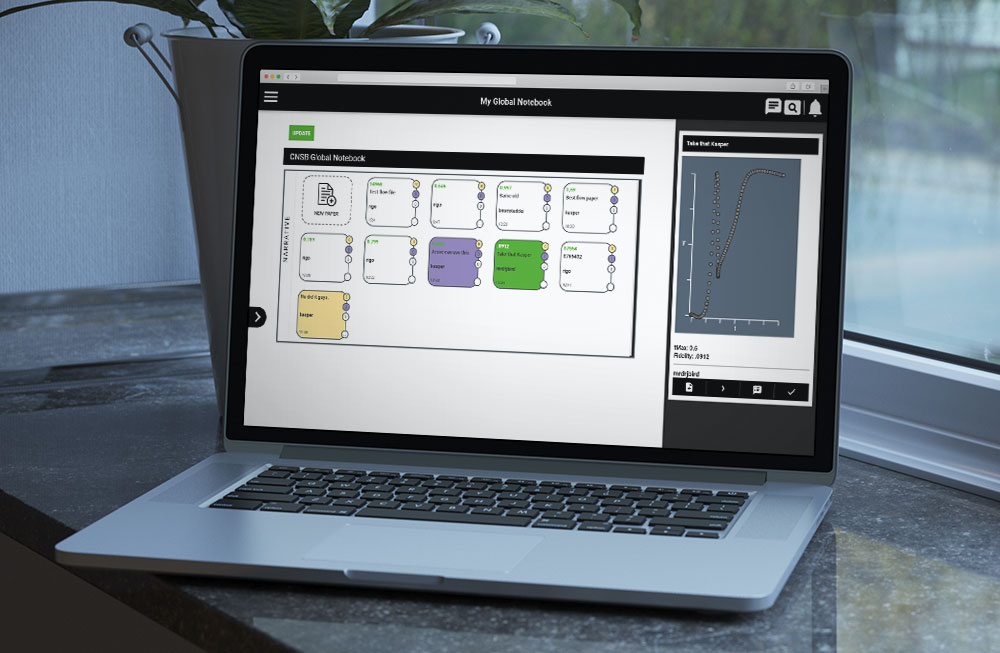ArguNotes
Read this page in Danish.
We have recently changed the name from SciNote to ArguNotes. The new name, ArguNotes, refers to the collaborative student argumentation interface built on the flexible literate computing platform WebStrates.
Think like a scientist with ArguNotes
Empower your students to use scientific reasoning with ease using our intuitive and adaptable tool.
With ArguNotes, we offer a highly configurable, collaborative digital tool that emulates parts of scientific reasoning to suit exactly your needs. The notebook will emulate parts of scientific reasoning, like:
- Form hypotheses, and verify or falsify them
- Generate evidence and evaluate how it informs your hypothesis
- Communicate with your peers and scrutinize your findings through critical discussion
- Explore new ideas or hypotheses that are based on previous work
These elements are important parts of why science is such a successful human enterprise, and now we are enabling students and citizens to use these and more aspects of scientific reasoning themselves. Compared to other tools, the notebook can be adapted so it will support any case you can imagine, whether the case requires geo-tagging, file-sharing, data visualisation or more.
In the primary and high school of Denmark, there is an increasing demand to provide teachers with tools they can use to teach scientific reasoning, that enables the students to design the projects and gather information themselves, while the teacher supervises from the sidelines if necessary.

Using ArguNotes in class
The notebook allows users to create and share papers on whatever project they are working on in order to generate better knowledge. For example, a teacher might ask the class the question, “Why is humanity the dominant species on Earth?”, and then have the students write papers where they tell their thoughts on the issue and then everyone can see each other’s papers, show their praise or criticism for them, and even build new papers that are based on other papers.
For example, one student writes a paper saying that perhaps humanity is dominant because humans have the biggest brains. Then another student reads up on this, maybe in a Wikipedia article, and realize that it is not the case that humans have the biggest brains, and this will get the paper discarded, because the hypothesis the paper posed was falsified. Or maybe a student likes the idea that it must have something to do with brains, and makes a new paper that poses the hypothesis that while humans do not have the largest brain overall, maybe we have the largest brain relative to our body size? The student can then cite the previous paper on brain size and publish a new paper.
Ever had a student google an answer, but you know that the answer they found is wrong? ArguNotes enables and encourages students to be critical thinkers and not believe everything they find. Ideas will be generated and die out and be built upon as the students see fit, and while the students are using the notebook, the teacher can guide them in the specific use case and by themselves they will use scientific reasoning to generate hypotheses, publish them, have them evaluated by their peers, falsify them or use the well-evaluated papers to be built upon and generate even better papers to be published. In the end, the users will have been taught and used scientific reasoning together to find reliable knowledge about the world.

Scientific reasoning in detail
- Problem identification: What is the purpose of identifying a problem? For example:
- advance theories,
- develop solutions to problems based on scientific findings, or
- develop new technology.
- Questioning: Make a relevant set of questions for addressing the problem.
- Hypothesis generation: Generation of possible answers to the proposed questions.
- Selection of scientific tools: Select what tools to use to test the set of hypothesis, for example a microscope, or maybe make your own tool.
- Generate evidence: generating information to falsify the set of hypothesis. This can be done in a hypothetico-deductive way or theory driven.
- Evaluate evidence: Assess the degree to which the evidence supports a claim.
- Draw conclusions: Compare the different pieces of evidence and conclude whether your hypothesis is supported or falsified.
- Communication and scrutinising: share what you have learned with your peers and compare your results.
Contact
For more information about using ArguNotes in your class contact: argunotes@scienceathome.org
